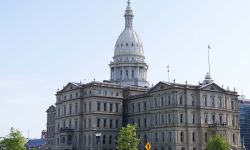Michigan college towns were economically stable. Coronavirus changed that.

Spring is usually good to E.J. Jonna, who counts on end-of-semester parties and graduation to drive business at his market on Grand River Avenue on the edge of Michigan State University’s campus.
Coronavirus changed that. Catering orders dried up. So did keg sales. Jonna’s 2 Go is open, but with classes canceled and fewer students and staff on campus, customers are rare.
“It’s like a ghost town,” Jonna said.
Now, as MSU weighs how fall semester will take shape, Jonna wonders how long the 85-percent drop in his business will continue. He’s not pressing school officials to reopen before it’s safe, but also knows that canceling in-person classes or the chance to tailgate will affect his store. “We live and die by a great football season,” Jonna said.
- Michigan Gov. Whitmer extends coronavirus stay-at-home order to May 28
- Whitmer reopens Michigan from coronavirus in phases: What that means to you
- The latest: Michigan coronavirus map, curve, chart, updated COVID-19 news
The COVID-19 pandemic isn’t just a higher education problem in college towns. The virus is shaking the economics of places like East Lansing, Ann Arbor and other cities in Michigan where students and their schools shape communities.
Colleges are bracing for enrollment declines and warning of budget shortfalls, layoffs and other side effects of social-distancing measures launched in March. Many are still looking at contingency plans for how they’ll operate if the public health crisis extends into fall, with options ranging from smaller classes to online-only courses. Sporting events, performances and other extracurriculars all hang in the balance.
The decisions made in coming weeks will ripple through the budgets of municipalities, stores, restaurants and landlords, say many people familiar with the particular challenges facing college towns.
“The institutions themselves are significant regional economic engines,” said Dan Hurley, CEO of the Michigan Association of State Universities.
“You have a cadre of employees that are higher paid,” Hurley said. As a sector, they employ “a workforce with a higher level of educational attainment and income,” he said. Benefits that many college towns share include intellectual assets, creative aspects and diversity -- and the wages and spending generated from campuses.
The University of Michigan charts its economic value to every county in Michigan, thanks to measures like 3 million medical visits, 245,000 in-state alumni, plus students and staff. The total payroll, according to the university, tops $3.8 billion. And its purchases within the state reach $1.5 billion. U-M hasn’t announced its plans for the fall, though the university is leaning toward a student return to Ann Arbor.
Similar stories can be found in college towns across the state: Houghton, for example, is the main beneficiary from the $70 million spent in 2015-16 by Michigan Technological University students, according to a 2018 study by Anderson Economic Group. Of that, 58 percent was on off-campus housing and groceries. Michigan Tech has announced plans to return to in-person classes in the fall.
Ferris State University is the largest employer in Mecosta County, north of Grand Rapids. Grand Valley State University (which also plans to have students back in September) tells prospective students that it is responsible for an estimated $849 million in spending in the greater Grand Rapids area.
The impact reaches smaller private schools and their communities, too. Albion College touts community development efforts on its webpage. A study from a decade ago at Kalamazoo College website credits students and visitors with $5.6 million in spending.
Even Detroit’s development resurgence in and near downtown is driven in part by the strength of Wayne State University attracting students, building new housing and investing in neighborhood opportunities, said Lou Glazer, economist at Michigan Future Inc.
“You can’t imagine what’s happening in Midtown without Wayne State,” Glazer said.
‘Shakeout period’
Ann Arbor had been called recession-proof before 2008, recalls Amy Cell, when Pfizer announced it was leaving the city along with 2,000 jobs. It was a scary time in Ann Arbor, made worse as the Great Recession took hold of the United States.
But over 10 years, Ann Arbor avoided the worst of it, thanks in part to U-M, Cell said. The university bought the former Pfizer headquarters, launching the North Campus Research Complex and employing more people than when Pfizer occupied it. That’s a sign of the power of the university in Ann Arbor, she said, where it employs 50,438 people between campus and its medical center.
Now that U-M President Mark Schlissel is warning of possible layoffs and up to a $1 billion budget shortfall, Ann Arbor is looking on with some disbelief, Cell said. That’s been amplified since Michigan Medicine announced 1,400 furloughs this week.
“The university has always been a sheltering buffer,” said Cell, a recruiter and former talent director for Michigan.
Employment at U-M’s facilities in Ann Arbor grew by more than 6,000 positions from 2015 to 2019, according to its Office of Budget and Planning. Residents over those years have expressed some frustration with housing availability, gentrification and lack of communication with U-M officials, but employment stability seemed assured.
Ann Arbor’s U-M employment growth helped to drive development as midwest and national investors recognized the profit-making potential of Michigan’s larger college towns. In East Lansing last fall, Target opened a small-format store on the edge of campus, near waves of new construction. In Ann Arbor, the streets around U-M’s main campus have been transformed by high-rises. Now landlords are wondering what kinds of changes they’ll have to absorb, said Bill Kinley, a longtime developer and co-owner of Praxis Properties. They range from short-term rental hosts, which just rode out a canceled graduation weekend, to new apartment developers who may need to lease at top dollar to cover construction costs. Rents, Kinley said, may have seemed like they’d go up forever.
“Think about those thousands of new apartments that have been built between downtown and campus that are almost 99 percent students,” Kinley said.
Restaurants felt the brunt of it starting in March, as many students left town. Ashley’s sits on South State Street, across from The Diag and the thousands of people who might walk past daily. After the shift to online classes, co-owner Jeff More closed it “because so much of our population that normally drives our business wasn’t going to be there.”
He’s reopening this spring when the state allows it, but wonders what will be different. Restaurants face capacity challenges, he said, while owners also question how many people are ready to return to campus before there’s a vaccination for coronavirus.
For Ashley’s, the concern isn’t just about the number of students in Ann Arbor, More said. It’s also about the culture of Ann Arbor.
“Ann Arbor has been an entertainment mecca,” More said, mentioning concerts, Top of the Park summer celebrations and University Musical Society performances. “How will it survive a year of not having any performances?”
The region also normally thrives on tourism. Ann Arbor gets about 4 million visitors a year, said Chad Wiebesick of Destination Ann Arbor.
“The number one attraction for visitors to Ann Arbor is the University of Michigan,” Wiebesick said. About 28 percent come to town for U-M sports.
U-M is reaching out to community groups as multiple Ann Arbor-based university committees plan for fall. Conversations include business groups, city government, and the Washtenaw United Way, said spokesperson Rick Fitzgerald. A decision is likely to be made in early summer, U-M has said.
“Will U-M and Ann Arbor survive? Absolutely,” Kinley said. “But the shakeout period until we get a vaccine could take a year or two years, and that could create a lot of economic devastation in its path.”
Initial solutions
Michigan’s largest college towns are trying to determine their vulnerability. Ann Arbor’s recent $400 million budget proposal will show up to a 10 percent loss municipal revenue due to COVID-19, Mayor Christopher Taylor said during a Facebook live town hall on April 26.
State revenue sharing, parking revenue and scaled-down water usage all will impact the Ann Arbor budget. Ann Arbor cyclically floats the idea of setting a city income tax to capture some financial benefit from the tens of thousands of university employees who work there, but hasn’t taken that step.
East Lansing already has a city income tax, as does Lansing. Janet Lillie, assistant vice president for community relations at MSU, said questions are already being raised about what working from home may mean to those tax collections, even as MSU has not announced layoffs.
Another concern facing college towns is the response to the U.S. Census. Counts were underway as in-person classes were canceled, and now outreach to increase responses has also been halted.
The situation is a “particularly critical issue facing those communities,” said Summer Minnick of the Michigan Municipal League, “as it could greatly impact their funding in ways that could exacerbate the financial impacts of COVID-19 for the next decade.”
The MML is working with the National League of Cities to encourage Congress to take steps that would help university towns. According to a letter sent last week, they hope allowing new counting methods or funding recounts in communities with substantial shifts in their counts will mitigate what appears to be lower numbers in college towns.
One of the national examples cited in the letter is Mt. Pleasant, home to Central Michigan University and 26,000 people, about half estimated to be students. State stay-at-home orders cancelled all census events and door-to-door outreach, and now the city is just one in Michigan fearful of the results.
“Census response rates in student-heavy neighborhoods now trail other neighborhoods by 20-30%,” according to the letter.
One example of the discussion is to make sure student-related businesses, like apartment complexes, get protocols in place that align as much as possible with the university’s, Lillie said.
Supporting local businesses that depend on students is another community focus. The East Lansing Downtown Development Authority dedicated $250,000 in grant funding that will be divided among 100 small businesses.
Meanwhile, some also are considering pandemic economic recovery. MSU, U-M and Wayne State comprise the University Research Corridor, which was created to accelerate research funding and opportunities in the state. As of 2018, the URC’s economic impact was estimated at $18.6 billion. That signals what universities can mean to their communities and to the state as they emerge from the pandemic downturn, Hurley said.
“If you look at the most prosperous, successful mid-size metros around the country, they’re all college towns,” said Michigan Future’s Glazer.
That’s not because of the extra spending by students, Glazer said. Instead, it’s the opportunity to turn them into well-paid residents, highly educated employees and entrepreneurs. All are predictors of economic success.
“Having a college is a real asset,” Glazer said, “and it’s going to be, going forward.”
RESOURCES:
- Hey, Michigan, here’s how to make a face mask to fight coronavirus
- Michigan coronavirus dashboard: cases, deaths and maps
- Michigan families can get food, cash, internet during coronavirus crisis
- How to give blood in Michigan during the coronavirus crisis
- 10 ways you can help Michigan hospital workers right now
- Michigan coronavirus Q&A: Reader questions answered
- How to apply for Michigan unemployment benefits amid coronavirus crisis
Business Watch
Covering the intersection of business and policy, and informing Michigan employers and workers on the long road back from coronavirus.
- About Business Watch
- Subscribe
- Share tips and questions with Bridge Business Editor Paula Gardner
Thanks to our Business Watch sponsors.
Support Bridge's nonprofit civic journalism. Donate today.
See what new members are saying about why they donated to Bridge Michigan:
- “In order for this information to be accurate and unbiased it must be underwritten by its readers, not by special interests.” - Larry S.
- “Not many other media sources report on the topics Bridge does.” - Susan B.
- “Your journalism is outstanding and rare these days.” - Mark S.
If you want to ensure the future of nonpartisan, nonprofit Michigan journalism, please become a member today. You, too, will be asked why you donated and maybe we'll feature your quote next time!




